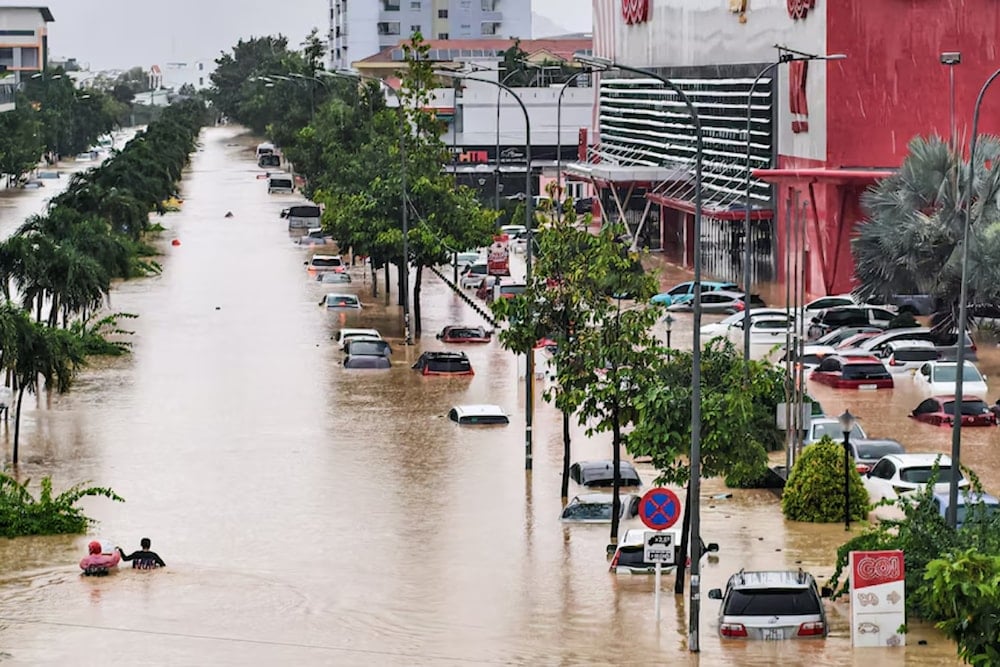Death toll climbs as Central Vietnam reels from devastating floods
Severe flooding and landslides across Vietnam's south-central and Central Highlands regions have killed 90 people, left communities isolated, devastated crops and infrastructure, and triggered a large-scale emergency response as authorities warn of increasingly extreme weather linked to climate change.
-

Vietnam's coastal province of Khanh Hoa was one of the areas hit hard by the rains. (AFP/ Duc Thao)
Vietnam’s south-central and Central Highlands regions are facing the aftermath of one of the country’s most destructive flood events in recent years, with authorities confirming 90 fatalities and 12 missing after nearly a month of relentless downpours, flash floods, and landslides.
Heavy rain has pounded the area since late October, driven by a persistent convergence of storm systems that repeatedly soaked the same provinces and overwhelmed already saturated soils. Some central localities recorded more than 1,500 mm of rain in a matter of days, according to meteorological briefings earlier in the week, setting off a chain reaction of deadly floods.
Vietnam UNDERWATER — record floods submerge over 116,000 homes and 5,000 hectares of crops
— RT (@RT_com) November 1, 2025
The cities of Hue, Hoi An and Da Nang are drowning as rivers burst their banks, 13 dead so far
The tourist paradise has turned into a sea of mud pic.twitter.com/s0QfvR63is
Dak Lak at the Center of the Crisis
The Central Highlands province of Dak Lak has borne the greatest share of the disaster. More than 60 of the confirmed deaths since November 16 occurred there, and several communes remained underwater as of Sunday. Entire neighborhoods were swept away as rivers swelled and mudslides tore through rural areas.
61-year-old farmer Mach Van Si described the moment he realized the water was rising too fast for him and his wife to escape.
"Our neighborhood was completely destroyed. Nothing was left. Everything was covered in mud," he told AFP. "I just thought we were going to die because there was no way out," he said.
The couple climbed onto the sheet-metal roof of their home, where they spent two nights surrounded by floodwaters that obliterated surrounding houses.
VIDEO: 🇻🇳 Vietnam flooding submerges homes after relentless rain
— AFP News Agency (@AFP) November 21, 2025
Floods submerged homes in Gia Lai and rescuers evacuate stranded people from the streets of Khanh Hoa as widespread flooding hit central Vietnam, killing at least 41 people pic.twitter.com/45J7nrgNh7
Tourism Hubs and Coastal Areas Submerged
The flooding stretched far beyond mountain villages. In the coastal city of Nha Trang, entire streets disappeared underwater last week, while landslides blocked the mountain passes connecting the famous Da Lat hill station. In Khanh Hoa province, two suspension bridges were washed away, isolating clusters of households and complicating rescue operations.
Earlier casualty updates from Vietnamese media had reported 41 dead around November 20, rising to 55 dead two days later, before numbers surged as rescue teams reached previously inaccessible locations.
Agricultural and Infrastructure Destruction
The floods have devastated livelihoods across the region:
- More than 80,000 hectares of rice fields and crops were destroyed.
- Roughly 3.2 million livestock and poultry drowned or were swept away.
- Central transport arteries suffered heavy damage, with national highways choked by landslides and several railway segments suspended.
- Power outages peaked at over one million customers, dropping to 129,000 still without electricity on Sunday.
Officials estimate $343 million in economic losses across five provinces, a figure expected to rise as assessments continue.
Large-Scale Emergency Response
Vietnam has mobilized a wide network of responders, including the military, to deliver aid to flood-stricken regions. Helicopters have been airdropping supplies to communities cut off by washed-out roads, while teams on the ground are distributing water-purification tablets, instant noodles, clothing, and other essentials.
Local and international humanitarian organizations, including church-based charities, have also begun relief operations in remote villages that remain cut off.
"Crushed instant noodle is still instant noodle!"
— Lee Ann Quann (@AnnQuann) November 23, 2025
A Mi-8/17 helicopter of Vietnam People Air Force dropping wrapped packages of supplies to expecting civilians in one of the areas cut off by the flood. The wrapping keeps the water out and lessens some of the impact. pic.twitter.com/31v0mR6Br8
A Country Increasingly Exposed
The tragedy comes amid a year of severe climate-related disasters in Vietnam. Between January and October alone, floods, storms, and landslides killed or left missing 279 people and caused more than $2 billion in damage, according to national statistics.
Scientists have long warned that human-driven climate change is intensifying extreme rainfall in Southeast Asia, compounding flood risks in regions like central Vietnam, where steep terrain and densely populated river basins leave communities acutely vulnerable. This latest disaster follows multiple tropical systems earlier in the season that had already saturated the soil, making the region even more prone to landslides.
With key roads blocked, agricultural land buried under mud, and entire villages still isolated, recovery is expected to take months. For residents like Mach Van Si, who watched his neighborhood disappear beneath a torrent of water and earth, the scale of loss is only beginning to register.
Read more: South Sudan floods could impact over one million people

 4 Min Read
4 Min Read








